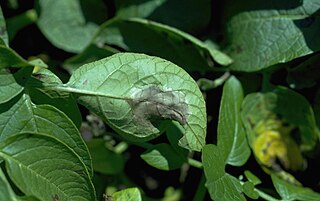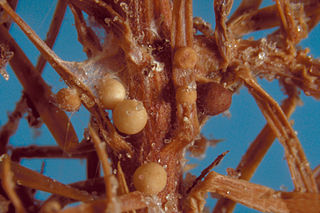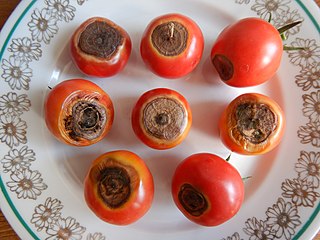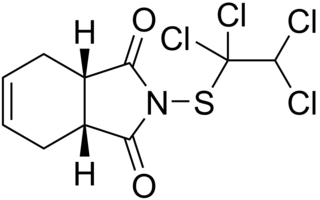
Qo inhibitors (QoI), or quinone outside inhibitors, are a group of fungicides used in agriculture. Some of these fungicides are among the most popular in the world. QoI are chemical compounds which act at the quinol outer binding site of the cytochrome bc1 complex.

Phytophthora infestans is an oomycete or water mold, a fungus-like microorganism that causes the serious potato and tomato disease known as late blight or potato blight. Early blight, caused by Alternaria solani, is also often called "potato blight". Late blight was a major culprit in the 1840s European, the 1845–1852 Irish, and the 1846 Highland potato famines. The organism can also infect some other members of the Solanaceae. The pathogen is favored by moist, cool environments: sporulation is optimal at 12–18 °C (54–64 °F) in water-saturated or nearly saturated environments, and zoospore production is favored at temperatures below 15 °C (59 °F). Lesion growth rates are typically optimal at a slightly warmer temperature range of 20 to 24 °C.

Botrytis cinerea is a necrotrophic fungus that affects many plant species, although its most notable hosts may be wine grapes. In viticulture, it is commonly known as "botrytis bunch rot"; in horticulture, it is usually called "grey mould" or "gray mold".

Famoxadone is a fungicide to protect agricultural products against various fungal diseases on fruiting vegetables, tomatoes, potatoes, curcurbits, lettuce and grapes. It is used in combination with cymoxanil. Famoxadone is a QoI, albeit with a chemistry different from most QoIs. It is commonly used against Plasmopara viticola, Alternaria solani, Phytophthora infestans, and Septoria nodorum.
Fungicides are biocidal chemical compounds or biological organisms used to kill parasitic fungi or their spores. A fungistatic inhibits their growth. Fungi can cause serious damage in agriculture, resulting in critical losses of yield, quality, and profit. Fungicides are used both in agriculture and to fight fungal infections in animals. Chemicals used to control oomycetes, which are not fungi, are also referred to as fungicides, as oomycetes use the same mechanisms as fungi to infect plants. Fungicides can either be contact, translaminar or systemic. Contact fungicides are not taken up into the plant tissue and protect only the plant where the spray is deposited. Translaminar fungicides redistribute the fungicide from the upper, sprayed leaf surface to the lower, unsprayed surface. Systemic fungicides are taken up and redistributed through the xylem vessels. Few fungicides move to all parts of a plant. Some are locally systemic, and some move upwardly.

Fusarium wilt is a common vascular wilt fungal disease, exhibiting symptoms similar to Verticillium wilt. This disease has been investigated extensively since the early years of this century. The pathogen that causes Fusarium wilt is Fusarium oxysporum. The species is further divided into formae speciales based on host plant.

Chlorothalonil (2,4,5,6-tetrachloroisophthalonitrile) is an organic compound mainly used as a broad spectrum, nonsystemic fungicide, with other uses as a wood protectant, pesticide, acaricide, and to control mold, mildew, bacteria, algae. Chlorothalonil-containing products are sold under the names Bravo, Echo, and Daconil. It was first registered for use in the US in 1966. In 1997, the most recent year for which data are available, it was the third most used fungicide in the US, behind only sulfur and copper, with 12 million pounds used in agriculture that year. Including nonagricultural uses, the United States Environmental Protection Agency (EPA) estimates, on average, almost 15 million lb (6.8 million kg) were used annually from 1990 to 1996.

Iprodione is a hydantoin fungicide and nematicide.

Alternaria alternata is a fungus which has been recorded causing leaf spot and other diseases on over 380 host species of plant. It is an opportunistic pathogen on numerous hosts causing leaf spots, rots and blights on many plant parts.

Athelia rolfsii is a corticioid fungus in the family Atheliaceae. It is a facultative plant pathogen and is the causal agent of "southern blight" disease in crops.
Leveillula taurica is an obligate fungal pathogen, from the phylum Ascomycota, which causes powdery mildew on onion. This disease prefers warm, dry environments. It is rare in the United States, and is currently restricted to western states. Globally, it is also a minor problem with limited occurrences in the Middle East, Europe, and South America. L. taurica causes powdery mildew of onions, but is also known to infect other allium, solanaceous, and cucurbit species. The disease has appeared in parts of the Middle East, the Mediterranean, and South and North America. Currently, it is not a cause for major concern in the U.S. and throughout the world, as its geographic extent is sparse. In addition, it is relatively easy to control through basic sanitation and reducing water stress.

Corynespora cassiicola is a species of fungus well known as a plant pathogen. It is a sac fungus in the family Corynesporascaceae. It is the type species of the genus Corynespora.

Alternaria solani is a fungal pathogen that produces a disease in tomato and potato plants called early blight. The pathogen produces distinctive "bullseye" patterned leaf spots and can also cause stem lesions and fruit rot on tomato and tuber blight on potato. Despite the name "early," foliar symptoms usually occur on older leaves. If uncontrolled, early blight can cause significant yield reductions. Primary methods of controlling this disease include preventing long periods of wetness on leaf surfaces and applying fungicides. Early blight can also be caused by Alternaria tomatophila, which is more virulent on stems and leaves of tomato plants than Alternaria solani.

Anilazine (ǎ-nǐl-a-zēn) is an organic compound with the chemical formula C9H5Cl3N4. It is a pesticide used on crops. It comes under the category of triazine fungicides. It is used for controlling fungus diseases which attack lawns and turf, cereals, coffee, and a wide variety of vegetables and other crops. It is also used for the control of potato and tomato leafspots.

Captafol is a fungicide. It is used to control almost all fungal diseases of plants except powdery mildews. It is believed to be a human carcinogen, and production for use as a fungicide in the United States stopped in 1987. Its continued use from existing stocks was allowed, but in 1999 the Environmental Protection Agency banned its use on all crops except onions, potatoes, and tomatoes. In 2006 even these exceptions were disallowed, so currently its use on all crops is banned in the United States. Several other countries have followed suit since 2000, and as of 2010, no countries are known to allow the use of captafol on food crops. Currently, the National Institute for Occupational Safety and Health established a recommended exposure limit of 0.1 mg/m3 for dermal exposures.

Fenarimol, sold under the tradenames Bloc, Rimidin and Rubigan, is a fungicide which acts against rusts, blackspot and mildew fungi. It is used on ornamental plants, trees, lawns, tomatoes, peppers, eggplants, cucumbers and melons. It is mainly used to control powdery mildew. It works by inhibiting the fungus's biosynthesis of important steroid molecules.

Zinc dimethyldithiocarbamate is a coordination complex of zinc with dimethyldithiocarbamate. It is a pale yellow solid that is used as a fungicide, the sulfur vulcanization of rubber, and other industrial applications.

Fluxapyroxad is a broad-spectrum pyrazole-carboxamide fungicide used on a large variety of commercial crops. It stunts fungus growth by inhibiting the succinate dehydrogenase (SQR) enzyme. Application of fluxapyroxad helps prevent many wilts and other fungal infections from taking hold. As with other systemic pesticides that have a long chemical half-life, there are concerns about keeping fluxapyroxad out of the groundwater, especially when combined with pyraclostrobin. There is also concern that some fungi may develop resistance to fluxapyroxad.

Prochloraz, brand name Sportak, is an imidazole fungicide that was introduced in 1978 and is widely used in Europe, Australia, Asia, and South America within gardening and agriculture to control the growth of fungi. It is not registered for use in the United States. Similarly to other azole fungicides, prochloraz is an inhibitor of the enzyme lanosterol 14α-demethylase (CYP51A1), which is necessary for the production of ergosterol – an essential component of the fungal cell membrane – from lanosterol. The agent is a broad-spectrum, protective and curative fungicide, effective against Alternaria spp., Botrytis spp., Erysiphe spp., Helminthosporium spp., Fusarium spp., Pseudocerosporella spp., Pyrenophora spp., Rhynchosporium spp., and Septoria spp.
















